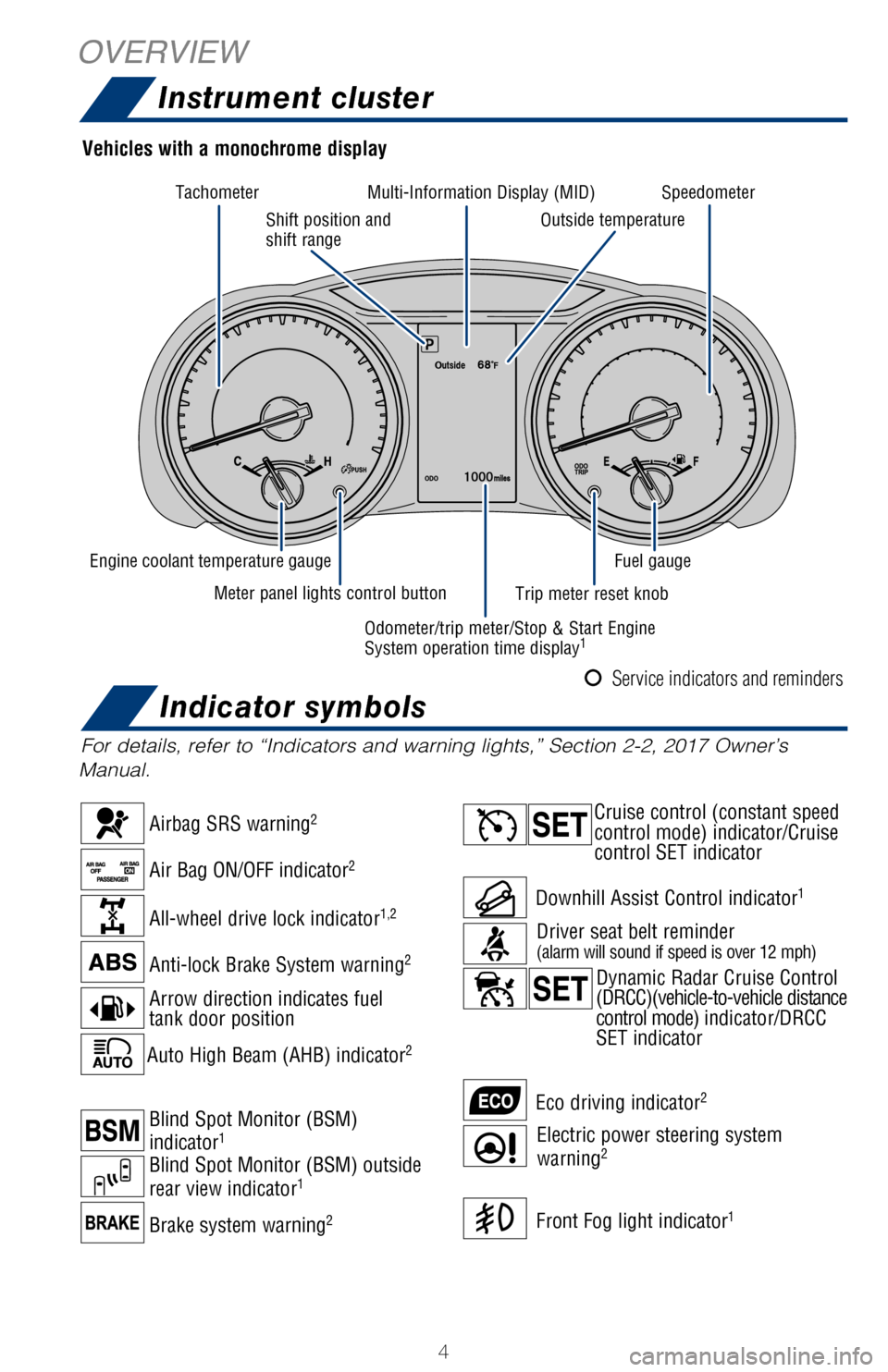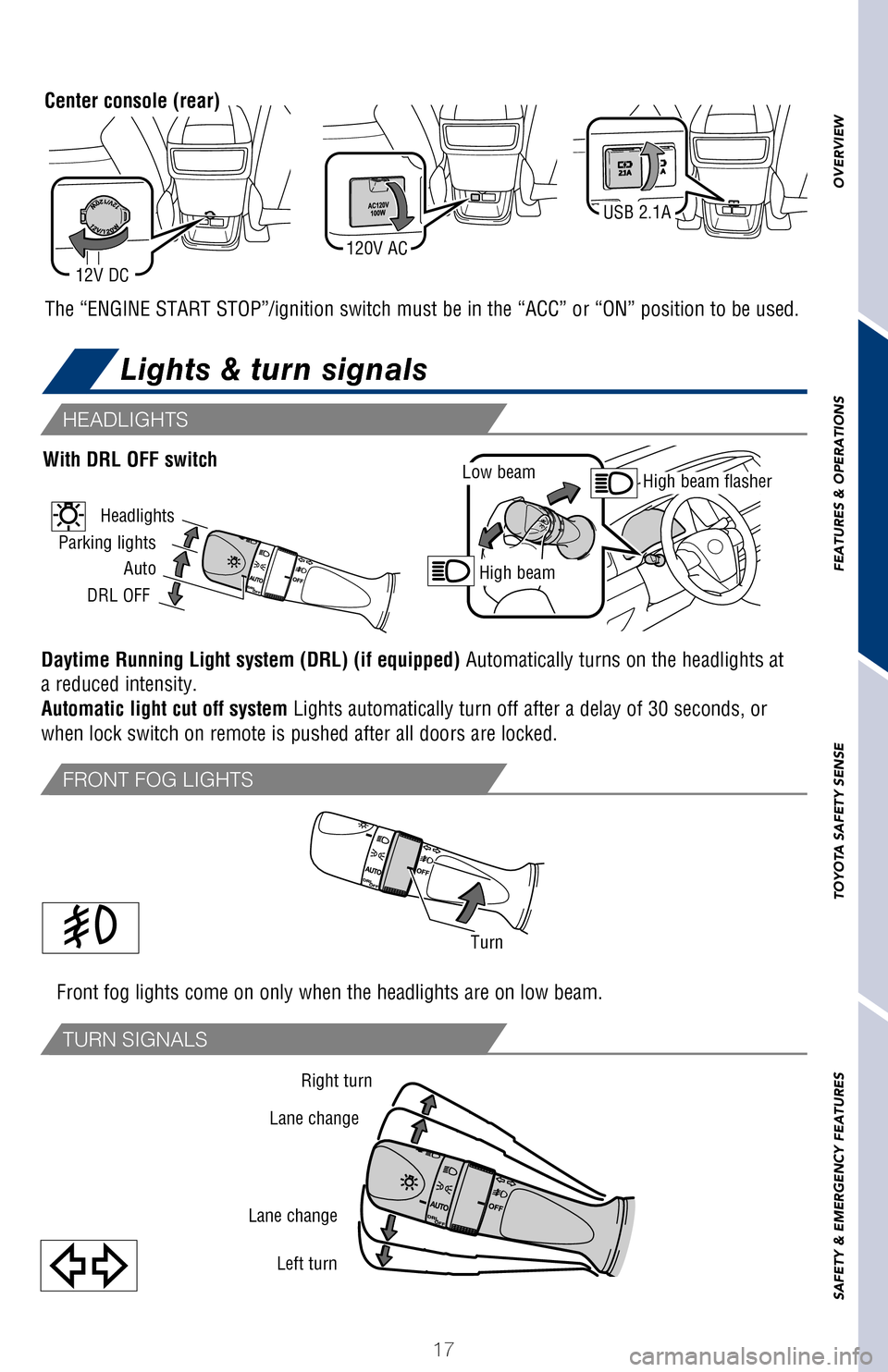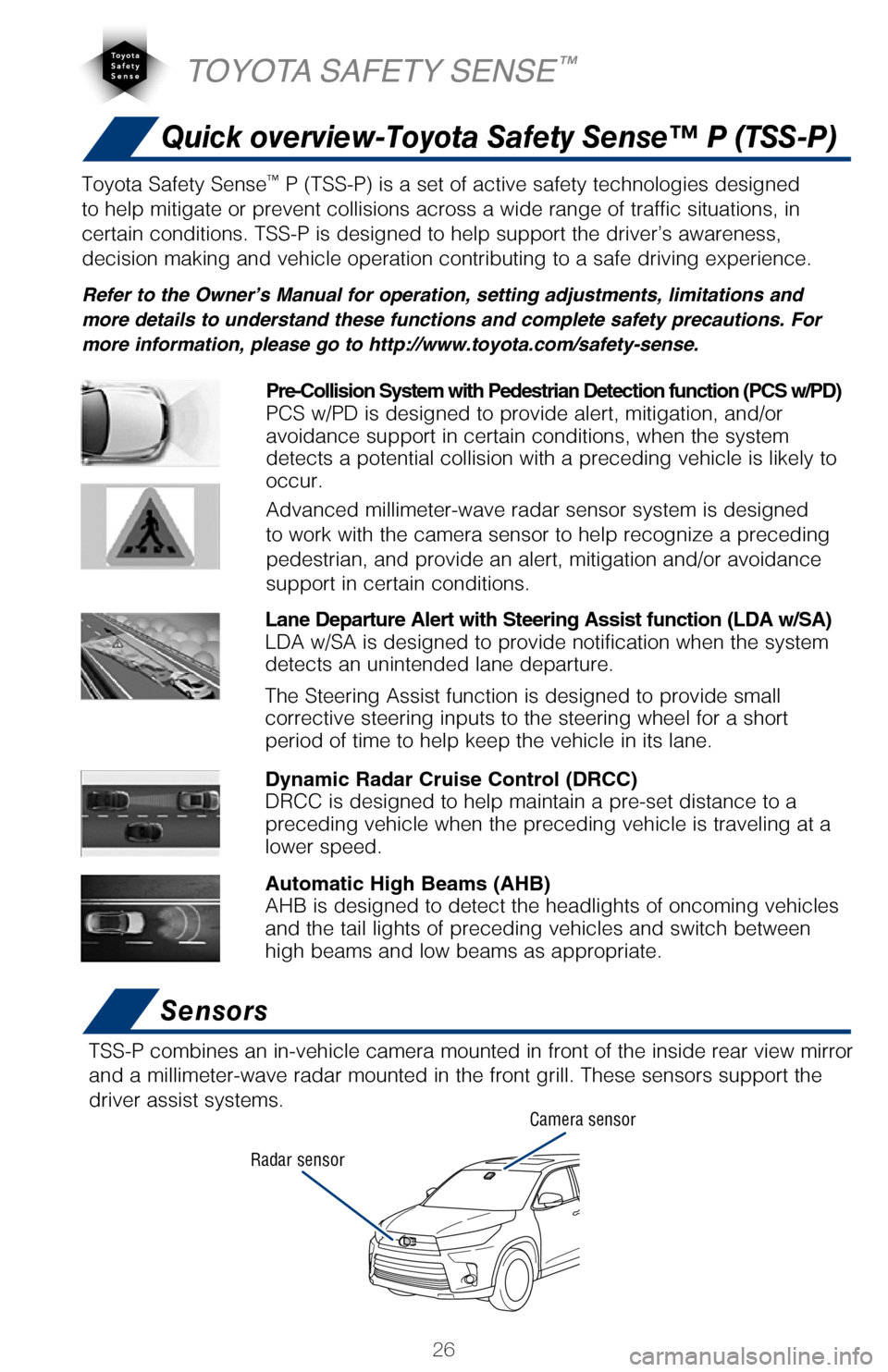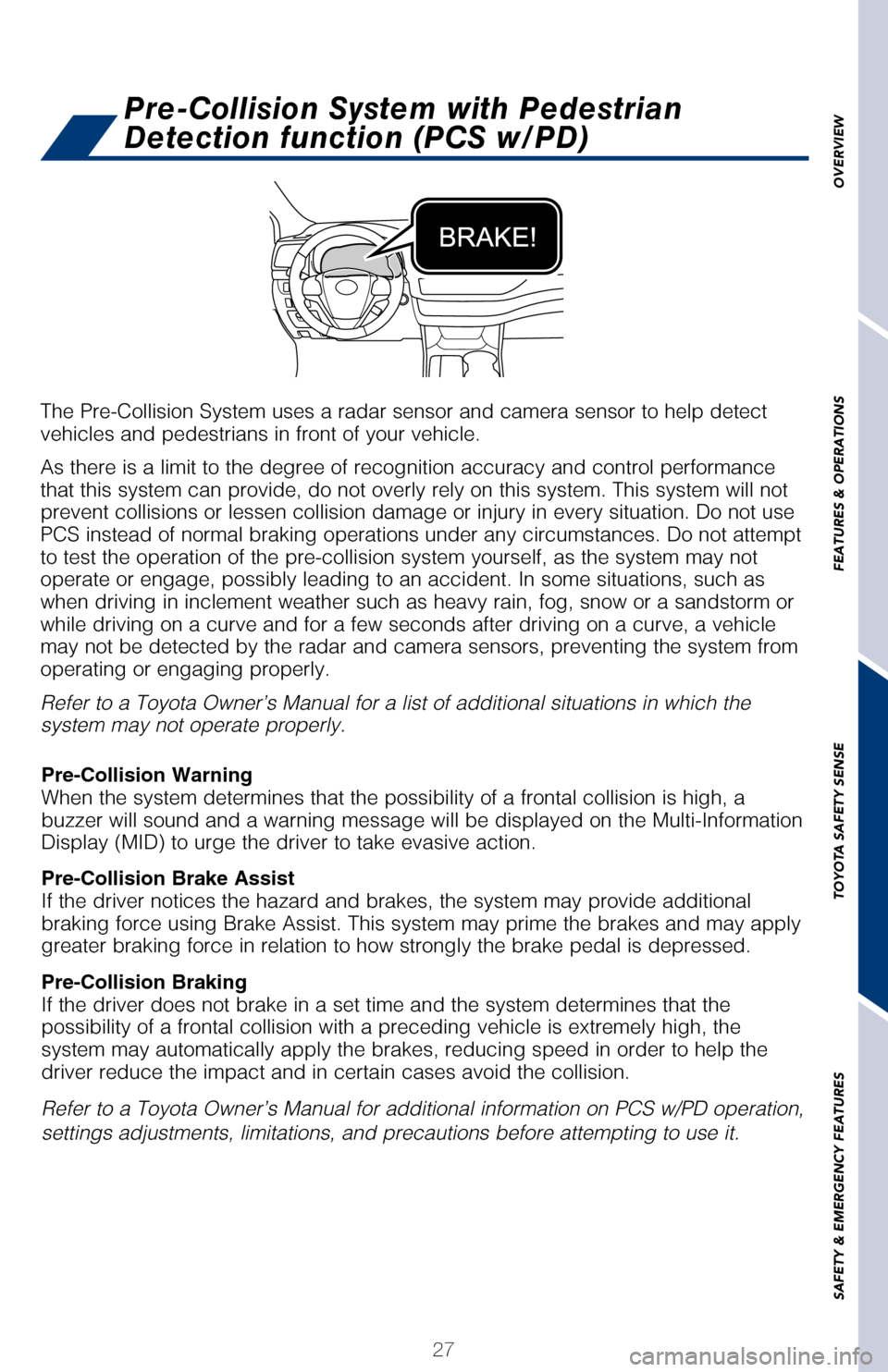fog light TOYOTA HIGHLANDER 2017 XU50 / 3.G Quick Reference Guide
[x] Cancel search | Manufacturer: TOYOTA, Model Year: 2017, Model line: HIGHLANDER, Model: TOYOTA HIGHLANDER 2017 XU50 / 3.GPages: 56, PDF Size: 3.78 MB
Page 4 of 56

2
Steering wheel controls
Audio remote
control switches2Multi-Information Display
(MID) switchesDynamic Radar Cruise
Control
(DRCC)
/Cruise control
Dynamic Radar
Cruise Control
(DRCC) vehicle-
to-vehicle distance
button
Lane Departure
Alert (LDA) switch
Tilt and telescopic steering
control switch
Headlight, turn signal and
front fog light controls
Meters
Windshield wiper and
washer controls
Clock
“ENGINE START
STOP” button
(Smart Key)
Ignition (Standard Key)
Hood lock release lever Fuel tank door release lever
Tire pressure warning reset switch
Windshield wiper de-icer switch
Heated steering wheel switch
1
Parking assist sensors switch1,2
Automatic High Beam (AHB) switch
Stop & Start Engine System cancel switch
1
Birds Eye View Camera switch1,2
Power back door switch1
Voice command switch2
Telephone
switches2 1
If equipped2 For details, refer to the “Navigation System Owner’s Manual” and “2017 Entune™ Audio
Quick Reference Guide.”
OVERVIEW
Instrument panel
2017_Highlander_QRG_V1_1.indd 211/22/16 11:28 PM
Page 6 of 56

4
For details, refer to “Indicators and warning lights,” Section 2-2\
, 2017 Owner’s
Manual.
Vehicles with a monochrome display
1 If equipped.2 If indicator does not turn off within a few seconds of starting engine, \
there may be a malfunction.
Have vehicle inspected by your Toyota dealer.
Front Fog light indicator1
Cruise control (constant speed
control mode) indicator/Cruise
control SET indicator
Electric power steering system
warning2
Downhill Assist Control indicator1
Arrow direction indicates fuel
tank door position Anti-lock Brake System warning
2
Airbag SRS warning2
Air Bag ON/OFF indicator2
Auto High Beam (AHB) indicator2
All-wheel drive lock indicator1,2
Brake system warning2
Blind Spot Monitor (BSM) outside
rear view indicator1
Blind Spot Monitor (BSM)
indicator1
Eco driving indicator2
Driver seat belt reminder(alarm will sound if speed is over 12 mph)
Dynamic Radar Cruise Control
(DRCC)(vehicle-to-vehicle distance
control mode) indicator/DRCC
SET indicator
Engine coolant temperature gauge Shift position and
shift range
Tachometer
Multi-Information Display (MID) Speedometer
Fuel gauge
Outside temperature
Trip meter reset knob
Odometer/trip meter/Stop & Start Engine
System operation time display
1
Meter panel lights control button
Service indicators and reminders
OVERVIEW Instrument cluster
Indicator symbols
2017_Highlander_QRG_V1_1.indd 411/22/16 11:28 PM
Page 18 of 56

16
Instrument panel
USB 2.1A12V DC
The “ENGINE START STOP”/ignition switch must be in the “ACC”\
or “ON” position to be used.
Center console (front)
Single wipeInterval wipe
Off
Push to Wash and wipe
1 Intermittent windshield wiper
frequency adjustment
Rotate to increase/decrease wipe
frequency.
2 Rain-sensing windshield wipers
Rotate to increase/decrease sensor
sensitivity. (if equipped)Temporary
operation
Rain sensing
(AUTO)Low
HighAdjust sensitivity2
Pull to wash
and wipe
Interval wipe
Mist
Slow
Fast
Adjust frequency
1
Pull to wash
and wipe
Center console (rear)
Front fog lights come on only when the headlights are on low beam.
Daytime Running Light system (DRL) (if equipped)
Automatically turns on the headlights at
a reduced intensity. Automatic light cut off system Lights automatically turn off after a delay of 30 seconds, or
when lock switch on remote is pushed after all doors are locked.
Parking lights
DRL OFF
With DRL OFF switch
12V DC
12V DC
Note: USB 2.1A for charging devices only.
HEADLIGHTS
FRONT FOG LIGHTS
TURN SIGNALS
FEATURES & OPERATIONS Windshield wipers & washers
Power outlets-
12V DC/120V AC/USB 2.1A (
if equipped)
FRONT-INTERMITTENT
FRONT-AUTO (RAIN-SENSING)
REAR
2017_Highlander_QRG_V1_1.indd 1611/22/16 11:29 PM
Page 19 of 56

OVERVIEW
FEATURES & OPERATIONS
TOYOTA SAFETY SENSE
SAFETY & EMERGENCY FEATURES
17
The “ENGINE START STOP”/ignition switch must be in the “ACC”\
or “ON” position to be used.
2 Rain-sensing windshield wipers
Rotate to increase/decrease sensor
sensitivity. (if equipped)
Center console (rear)
Front fog lights come on only when the headlights are on low beam.
Daytime Running Light system (DRL) (if equipped) Automatically turns on the headlights at
a reduced intensity. Automatic light cut off system Lights automatically turn off after a delay of 30 seconds, or
when lock switch on remote is pushed after all doors are locked.
Low beam
High beam
High beam flasher
Parking lights
Auto
DRL OFF
With DRL OFF switch
Headlights
Turn
Right turn
Lane change
Lane change Left turn
120V AC
12V DC
USB 2.1A
Note: USB 2.1A for charging devices only.
Lights & turn signals
HEADLIGHTS
FRONT FOG LIGHTS
TURN SIGNALS
Windshield wipers & washers
Power outlets-
12V DC/120V AC/USB 2.1A (
if equipped)
2017_Highlander_QRG_V1_1.indd 1711/22/16 11:29 PM
Page 28 of 56

26
Quick overview-Toyota Safety Sense™ P (TSS-P)
Sensors
TSS-P combines an in-vehicle camera mounted in front of the inside rear \
view mirror
and a millimeter-wave radar mounted in the front grill. These sensors su\
pport the
driver assist systems.
Camera sensor
Radar sensor
TOYOTA SAFETY SENSE™
The Pre-Collision System uses a radar sensor and camera sensor to help d\
etect
vehicles and pedestrians in front of your vehicle.
As there is a limit to the degree of recognition accuracy and control pe\
rformance
that this system can provide, do not overly rely on this system. This sy\
stem will not
prevent collisions or lessen collision damage or injury in every situati\
on. Do not use
PCS instead of normal braking operations under any circumstances. Do not\
attempt
to test the operation of the pre-collision system yourself, as the syste\
m may not
operate or engage, possibly leading to an accident. In some situations, \
such as
when driving in inclement weather such as heavy rain, fog, snow or a san\
dstorm or
while driving on a curve and for a few seconds after driving on a curve,\
a vehicle
may not be detected by the radar and camera sensors, preventing the syst\
em from
operating or engaging properly.
Refer to a Toyota Owner’s Manual for a list of additional situations \
in which the
system may not operate properly.
Refer to a Toyota Owner’s Manual for additional information on PCS w/\
PD operation,
settings adjustments, limitations, and precautions before attempting to \
use it. Pre-Collision Warning
When the system determines that the possibility of a frontal collision i\
s high, a
buzzer will sound and a warning message will be displayed on the Multi-I\
nformation
Display (MID) to urge the driver to take evasive action.
Pre-Collision Brake Assist
If the driver notices the hazard and brakes, the system may provide addi\
tional
braking force using Brake Assist. This system may prime the brakes and m\
ay apply
greater braking force in relation to how strongly the brake pedal is dep\
ressed.
Pre-Collision Braking
If the driver does not brake in a set time and the system determines tha\
t the
possibility of a frontal collision with a preceding vehicle is extremely\
high, the
system may automatically apply the brakes, reducing speed in order to he\
lp the
driver reduce the impact and in certain cases avoid the collision.
Toyota Safety Sense™ P (TSS-P) is a set of active safety technologies designed
to help mitigate or prevent collisions across a wide range of traffic si\
tuations, in
certain conditions. TSS-P is designed to help support the driver’s aw\
areness,
decision making and vehicle operation contributing to a safe driving exp\
erience.
Refer to the Owner’s Manual for operation, setting adjustments, limitations and
more details to understand these functions and complete safety precautions. For
more information, please go to http://www.toyota.com/safety-sense.
Lane Departure Alert with Steering Assist function (LDA w/SA)
LDA w/SA is designed to provide notification when the system
detects an unintended lane departure.
The Steering Assist function is designed to provide small
corrective steering inputs to the steering wheel for a short
period of time to help keep the vehicle in its lane.
Automatic High Beams (AHB)
AHB is designed to detect the headlights of oncoming vehicles
and the tail lights of preceding vehicles and switch between
high beams and low beams as appropriate.
Pre-Collision System with Pedestrian Detection function (PCS w/PD)
PCS w/PD is designed to provide alert, mitigation, and/or
avoidance support in certain conditions, when the system
detects a potential collision with a preceding vehicle is likely to
occur.
Advanced millimeter-wave radar sensor system is designed
to work with the camera sensor to help recognize a preceding
pedestrian, and provide an alert, mitigation and/or avoidance
support in certain conditions.
Dynamic Radar Cruise Control (DRCC)
DRCC is designed to help maintain a pre-set distance to a
preceding vehicle when the preceding vehicle is traveling at a
lower speed.
2017_Highlander_QRG_V1_1.indd 2611/22/16 11:29 PM
Page 29 of 56

27
OVERVIEW
FEATURES & OPERATIONS
TOYOTA SAFETY SENSE
SAFETY & EMERGENCY FEATURES
Quick overview-Toyota Safety Sense™ P (TSS-P)
Sensors
TSS-P combines an in-vehicle camera mounted in front of the inside rear \
view mirror
and a millimeter-wave radar mounted in the front grill. These sensors su\
pport the
driver assist systems.
The Pre-Collision System uses a radar sensor and camera sensor to help d\
etect
vehicles and pedestrians in front of your vehicle.
As there is a limit to the degree of recognition accuracy and control pe\
rformance
that this system can provide, do not overly rely on this system. This sy\
stem will not
prevent collisions or lessen collision damage or injury in every situati\
on. Do not use
PCS instead of normal braking operations under any circumstances. Do not\
attempt
to test the operation of the pre-collision system yourself, as the syste\
m may not
operate or engage, possibly leading to an accident. In some situations, \
such as
when driving in inclement weather such as heavy rain, fog, snow or a san\
dstorm or
while driving on a curve and for a few seconds after driving on a curve,\
a vehicle
may not be detected by the radar and camera sensors, preventing the syst\
em from
operating or engaging properly.
Refer to a Toyota Owner’s Manual for a list of additional situations \
in which the
system may not operate properly.
Refer to a Toyota Owner’s Manual for additional information on PCS w/\
PD operation,
settings adjustments, limitations, and precautions before attempting to \
use it. Pre-Collision Warning
When the system determines that the possibility of a frontal collision i\
s high, a
buzzer will sound and a warning message will be displayed on the Multi-I\
nformation
Display (MID) to urge the driver to take evasive action.
Pre-Collision Brake Assist
If the driver notices the hazard and brakes, the system may provide addi\
tional
braking force using Brake Assist. This system may prime the brakes and m\
ay apply
greater braking force in relation to how strongly the brake pedal is dep\
ressed.
Pre-Collision Braking
If the driver does not brake in a set time and the system determines tha\
t the
possibility of a frontal collision with a preceding vehicle is extremely\
high, the
system may automatically apply the brakes, reducing speed in order to he\
lp the
driver reduce the impact and in certain cases avoid the collision.
Pre-Collision System with Pedestrian
Detection function (PCS w/PD)
Toyota Safety Sense™ P (TSS-P) is a set of active safety technologies designed
to help mitigate or prevent collisions across a wide range of traffic si\
tuations, in
certain conditions. TSS-P is designed to help support the driver’s aw\
areness,
decision making and vehicle operation contributing to a safe driving exp\
erience.
Refer to the Owner’s Manual for operation, setting adjustments, limitations and
more details to understand these functions and complete safety precautions. For
more information, please go to http://www.toyota.com/safety-sense.
Lane Departure Alert with Steering Assist function (LDA w/SA)
LDA w/SA is designed to provide notification when the system
detects an unintended lane departure.
The Steering Assist function is designed to provide small
corrective steering inputs to the steering wheel for a short
period of time to help keep the vehicle in its lane.
Automatic High Beams (AHB)
AHB is designed to detect the headlights of oncoming vehicles
and the tail lights of preceding vehicles and switch between
high beams and low beams as appropriate. Pre-Collision System with Pedestrian Detection function (PCS w/PD)
PCS w/PD is designed to provide alert, mitigation, and/or
avoidance support in certain conditions, when the system
detects a potential collision with a preceding vehicle is likely to
occur.
Advanced millimeter-wave radar sensor system is designed
to work with the camera sensor to help recognize a preceding
pedestrian, and provide an alert, mitigation and/or avoidance
support in certain conditions.
Dynamic Radar Cruise Control (DRCC)
DRCC is designed to help maintain a pre-set distance to a
preceding vehicle when the preceding vehicle is traveling at a
lower speed.
2017_Highlander_QRG_V1_1.indd 2711/22/16 11:29 PM